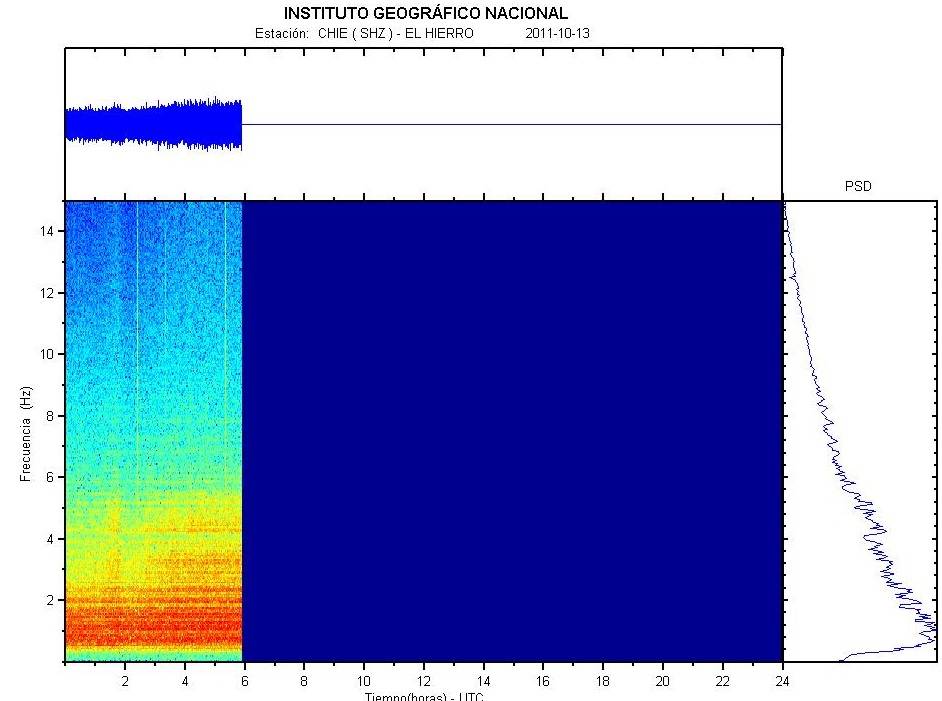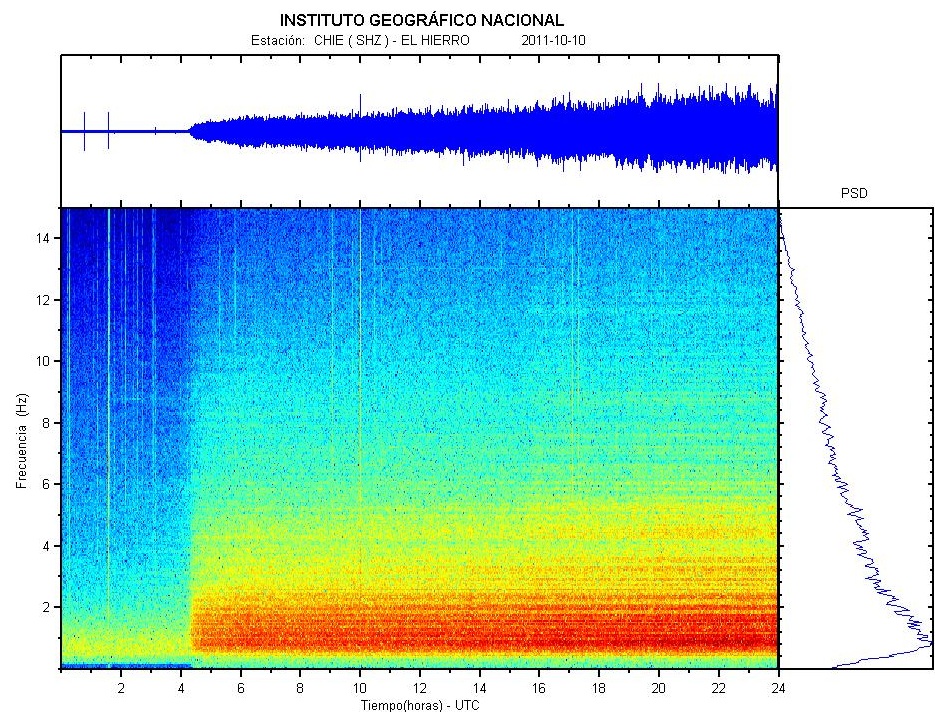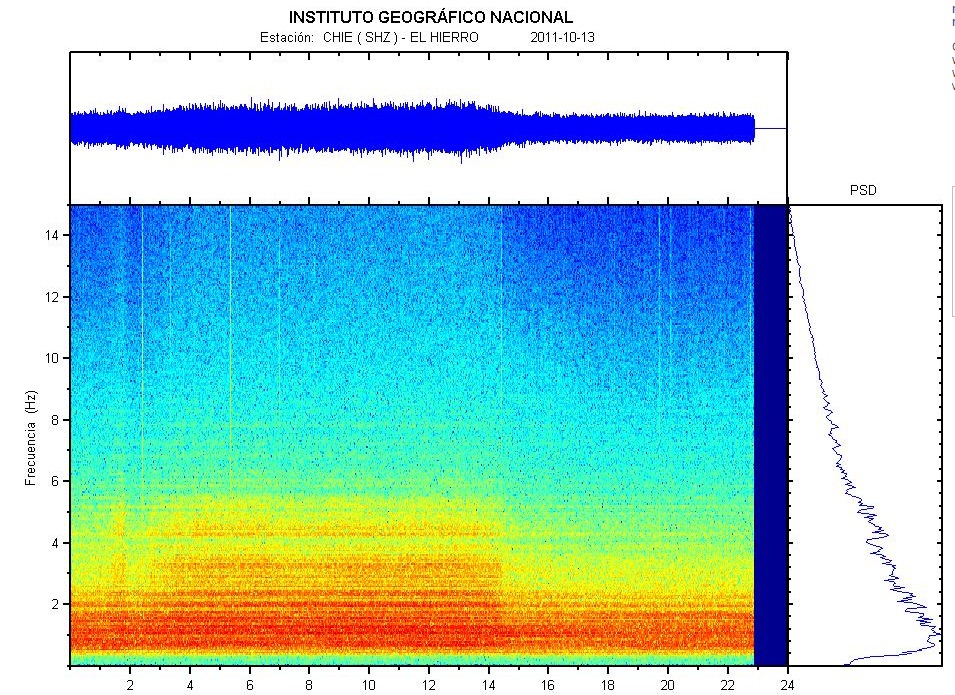It looks like you're using an Ad Blocker.
Please white-list or disable AboveTopSecret.com in your ad-blocking tool.
Thank you.
Some features of ATS will be disabled while you continue to use an ad-blocker.
share:
The latest -
Be Safe Everyone!
11/10/2011 20:42 – Joan Martí, a researcher at the CSIC (Instituto de Ciencias de la Tierra) and secretary of the ‘Asociación Internacional de Vulcanología’ (International association of vulcanology) has stated that “As the magma approaches the coast of El Hierro, it could trigger an explosive eruption if it occurs at a depth of less than 200 metres but would not be dangerous if appropriate safety measures are taken”. It is thought that the magma could be following a fault under the sea bed which is known to run underneath the island and could currently be looking for another way to escape to the surface. Scientists have observed that the magma is currently moving towards the centre of the island.
Be Safe Everyone!
reply to post by zenius
So much prettier than an electronic one isn't it.
Not quite sure how I would get to 'hear' that in Audacity however!
So much prettier than an electronic one isn't it.
Not quite sure how I would get to 'hear' that in Audacity however!
New updated blogg thread by jon Friemann for those of you interested in following events there
www.jonfr.com...
Rainbows
Jane
www.jonfr.com...
Rainbows
Jane
reply to post by PuterMan
www.01.ign.es...
Well for once I can state pretty confidently that IS harmonic tremor. See the bands? But what is interesting to me is the 1 Hz, almost exactly, center frequency of that tremor. That's pretty darn low for HT isn't it? I thought HT occurred mostly around 2 to 5 Hz? Well not this one.
Which then raises the question of what it might look like, and what frequency, at a place like Yellowstone or Toba.
Puterman, I don't suppose you have access to any raw data at Hierro, do you? Audio files of that SHZ signal would be very interesting.
Also, that HT lasted for TWO DAYS!!!
www.01.ign.es...
Well for once I can state pretty confidently that IS harmonic tremor. See the bands? But what is interesting to me is the 1 Hz, almost exactly, center frequency of that tremor. That's pretty darn low for HT isn't it? I thought HT occurred mostly around 2 to 5 Hz? Well not this one.
Which then raises the question of what it might look like, and what frequency, at a place like Yellowstone or Toba.
Puterman, I don't suppose you have access to any raw data at Hierro, do you? Audio files of that SHZ signal would be very interesting.
Also, that HT lasted for TWO DAYS!!!
edit on Wed Oct 12th 2011 by TrueAmerican because: (no reason given)
reply to post by TrueAmerican
No I have been trying to get data. Even emailed them but no response so far.
Actually I believe that to be volcanic tremor not harmonic tremor since it is so low and the banding is not on the harmonic frequencies.
No I have been trying to get data. Even emailed them but no response so far.
Actually I believe that to be volcanic tremor not harmonic tremor since it is so low and the banding is not on the harmonic frequencies.
reply to post by PuterMan
Well, whatever it is, it was pretty darn powerful. You seen the spectrals over the last two days, and webicorders?
I mean that thing kept the webis near clipped out. CONSTANTLY.
Well, whatever it is, it was pretty darn powerful. You seen the spectrals over the last two days, and webicorders?
I mean that thing kept the webis near clipped out. CONSTANTLY.
I have been following the posts but
not replying as I am more into learning
about volcanos than knowing about them.
Thanks all for the great information
and links provided. I see this one is
a bit of a puzzler. I just hope everyone
evacuated continues to stay away until
it is more known what is going on.
not replying as I am more into learning
about volcanos than knowing about them.
Thanks all for the great information
and links provided. I see this one is
a bit of a puzzler. I just hope everyone
evacuated continues to stay away until
it is more known what is going on.
Most
recent image:

Calmed down, but still active. How does this compare to prior activity?
Answering my own question:

The plot form the 10th.

Calmed down, but still active. How does this compare to prior activity?
Answering my own question:

The plot form the 10th.
edit on 13-10-2011 by jadedANDcynical because: linking and answering
Iceland's scientists warn Katla volcano activity increasing
Link
Link
"clusters of small earthquakes are being detected around Katla, which means an eruption could be imminent, seismologists say. The earthquakes have been growing in strength, too. After a long period of magnitude 3 tremors, a magnitude 4 quake was detected last week.
It is definitely showing signs of restlessness," said Einarsson, a professor of geophysics at the University of Iceland.
Teams of seismologists and geologists at the university are tracking the spike in seismic activity and working with disaster officials to prepare communities near Katla like Vik, a small town of some 300 people that is flanked by black sand beaches.
Civil defence authorities have been holding regular meetings with scientists. Disaster officials have also drafted an evacuation plan and set aside temporary housing, but many fear they may have less than an hour to evacuate once the volcano erupts."
Read more: www.ctv.ca...
So Katla is finally making her move. If we all recall the hoopla over Eyjafjallajokul's ashy fallout last year, several here on ATS thought that it was only a matter of time before Katla spoke up. Seems she now has things to say.
Debate away folks...
Link
Link
"clusters of small earthquakes are being detected around Katla, which means an eruption could be imminent, seismologists say. The earthquakes have been growing in strength, too. After a long period of magnitude 3 tremors, a magnitude 4 quake was detected last week.
It is definitely showing signs of restlessness," said Einarsson, a professor of geophysics at the University of Iceland.
Teams of seismologists and geologists at the university are tracking the spike in seismic activity and working with disaster officials to prepare communities near Katla like Vik, a small town of some 300 people that is flanked by black sand beaches.
Civil defence authorities have been holding regular meetings with scientists. Disaster officials have also drafted an evacuation plan and set aside temporary housing, but many fear they may have less than an hour to evacuate once the volcano erupts."
Read more: www.ctv.ca...
So Katla is finally making her move. If we all recall the hoopla over Eyjafjallajokul's ashy fallout last year, several here on ATS thought that it was only a matter of time before Katla spoke up. Seems she now has things to say.
Debate away folks...
edit on 13-10-2011 by palg1 because: For quote accuracy
reply to post by palg1
Katla was indeed rumbling quite a bit for a while, but the last several days have been very calm. I found ATS last year through friends of mine who were watching the big E eruption, and I have been tracking Iceland ever since.
I found your article to be interesting, especially the part about the locals saying that Katla does not give much warning.
Latest seismic info for katla:
en.vedur.is...=table
edit - wanted to add this link as well...Spacedman who is on that thread a lot lives there and provides some great info on seismic activity throughout his country
www.abovetopsecret.com...
Katla was indeed rumbling quite a bit for a while, but the last several days have been very calm. I found ATS last year through friends of mine who were watching the big E eruption, and I have been tracking Iceland ever since.
I found your article to be interesting, especially the part about the locals saying that Katla does not give much warning.
Latest seismic info for katla:
en.vedur.is...=table
edit - wanted to add this link as well...Spacedman who is on that thread a lot lives there and provides some great info on seismic activity throughout his country
www.abovetopsecret.com...
edit on 13-10-2011 by lasertaglover because: (no reason given)
Recent
spectra for El Hierro:

Looks like it is throttling down.
What are the occasional lines that run vertically and go all the way to the top of the lower graph?

Looks like it is throttling down.
What are the occasional lines that run vertically and go all the way to the top of the lower graph?
reply to post by jadedANDcynical
Those yellow lines are small earthquakes.
About that Katla article.
It's just fear mongering combined with stuff that has already been discussed a hundred times.
Katla will erupt one day, that's for sure, but it's not going to be today or tomorrow or next week.
There has been some swarms in the past weeks but none of them have lead to that big eruption the author is talking about. It could although have been an sign but there was no eruption.
The difference between 100 years ago and today is that if an eruption at katla/laki/Hekla/Torfa/... happens we would be immediately informed and we would know what's going on. With we I mean everyone on the planet and the governments would be able to inform the people about what to do and what not to do.
Those yellow lines are small earthquakes.
About that Katla article.
It's just fear mongering combined with stuff that has already been discussed a hundred times.
Katla will erupt one day, that's for sure, but it's not going to be today or tomorrow or next week.
There has been some swarms in the past weeks but none of them have lead to that big eruption the author is talking about. It could although have been an sign but there was no eruption.
The difference between 100 years ago and today is that if an eruption at katla/laki/Hekla/Torfa/... happens we would be immediately informed and we would know what's going on. With we I mean everyone on the planet and the governments would be able to inform the people about what to do and what not to do.
Originally posted by Nidwin
With we I mean everyone on the planet and the governments would be able to inform the people about what to do and what not to do.
Predicting the eruption at Katla is still going to be rough with all that ice on it. One of the eruption precursors- gas emissions- has got to be tougher to detect under a glacier. The same for magma chamber inflation- the glacier could affect GPS readings there too. So the quake swarms may be all the warning they get.
And I could see how understandably they are nervous with the quake swarms- one of which reached a 4+ mag. Wonder what that would have been with no glacier on it? A 5+? In which case all those quakes could really be stronger down there and the thing is getting ready to go any minute. Ice in that quantity changes the game a bit.
In El Hierro
It seems that the eruption(?) has reached the island ....
www.publico.es...
It seems that the eruption(?) has reached the island ....
www.publico.es...
edit on 14/10/11 by Kellys because: (no reason given)
I used Google to translate the page and after reading it again I think it is saying that the discoloured water from the underwater eruption has
reached the island ...
My bad
My bad
reply to post by crappiekat
Google Translate
Google Translate
The volcanic spot and makes landfall in El Hierro. RelacionadasLos JMNoticias scientific data point to a new eruption in El Hierro Spain have produced 64 natural disasters from 1980Un ship arrives tomorrow to discuss El Hierro erupcionesCanarias sends the research vessel 'Ignacio Hierro Lozano'El confirms two submarine eruptions "We are losing valuable data there not having a scientific ship "
See all
Researchers from non-tip (volcanological Institute of the Canary Islands) have confirmed that the stain Public gases caused by underwater eruptions and El Hierro has landed in the top of La Restinga, approximately two hours. The researchers, who are still unaware of the details, go to the place to try to find out more information.
The submarine eruption is occurring in the area near La Restinga, in the southeast of the island of El Hierro could drive "at most" 0.1 cubic kilometers, ie, equivalent to 40,000 Olympic swimming pools, according to volcanologist Superior Council of Scientific Investigaiones (CSIC), Joan Martí.
So, Marti explained that "you can not determine" the total volume for the moment, it is unknown how much lava is coming out but, in his view, the maximum volume should not be out "very different" to the historical eruptions the Canary Islands.
This volume will continue to contribute to the construction of an underwater mountain range that takes thousands, millions of years forming south of El Hierro and therefore "this episode of eruption is one more building in the area, so from this point of view, this should be seen as part of the normal. "
On the material you are going abroad, said that molten basalt is primarily to hit the water cools and becomes rock and, in terms of turquoise blue stain is observed on the water, explained that "probably" will be due to remobilization of sulfur and clay from the ocean floor that gets stirred up and becomes turbulent waters.
new topics
-
How To Spot Fake U.F.O. Photos
Aliens and UFOs: 8 hours ago -
Scary video of face in an abandoned house
Paranormal Studies: 10 hours ago
top topics
-
LA Mayor Bass Demanded $49M in Additional LAFD Cuts One Week Before Wildfires
Mainstream News: 14 hours ago, 17 flags -
Just Came Across These Unusual Old UFO Pics
Aliens and UFOs: 12 hours ago, 7 flags -
Scary video of face in an abandoned house
Paranormal Studies: 10 hours ago, 5 flags -
How To Spot Fake U.F.O. Photos
Aliens and UFOs: 8 hours ago, 4 flags -
Carry On!
Short Stories: 16 hours ago, 3 flags -
Sepultura - Territory - With New Drummer Greyson Nekrutman
Music: 15 hours ago, 2 flags
active topics
-
Fire insurance in LA withdrawn months ago
General Conspiracies • 39 • : Flyingclaydisk -
Trump says ownership of Greenland 'is an absolute necessity'
Other Current Events • 163 • : Scratchpost -
Los Angeles brush fires latest: 2 blazes threaten structures, prompt evacuations
Mainstream News • 395 • : Flyingclaydisk -
Archbisop Vigano Warns of Deep State and Deep Church
New World Order • 12 • : FlyersFan -
This should be plastered all over the airwaves
Mainstream News • 56 • : Flyingclaydisk -
Oh, Good Gosh. “Kremlin Warns Stay Away from Greenland.”
World War Three • 33 • : Dalamax -
How To Spot Fake U.F.O. Photos
Aliens and UFOs • 4 • : SteamyAmerican -
Just Came Across These Unusual Old UFO Pics
Aliens and UFOs • 6 • : NoCorruptionAllowed -
Trump's idea to make Canada the 51st US state: 'Potential is massive'
Mainstream News • 158 • : charlyv -
Dr. Demento
Music • 17 • : KrustyKrab
